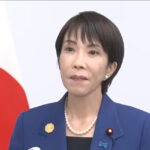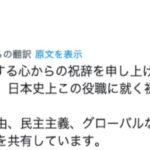Sanae Takaichi: Japan’s First Female Prime Minister 2025
A Political Earthquake in Tokyo: Sanae Takaichi Makes History
In October 2025, Japan witnessed a political moment that will be remembered for decades: Sanae Takaichi, a veteran conservative lawmaker from the Liberal Democratic Party (LDP), became Japan’s first female Prime Minister. Her victory in the LDP leadership race not only broke a symbolic glass ceiling but also triggered a new chapter in Japan’s post-war democracy. Across Tokyo, analysts described the result as nothing short of a political earthquake.
For more than seventy years, Japan’s political scene had been dominated by male leaders and factional power blocs. Takaichi’s election, held on October 4, 2025, marked a dramatic shift in both optics and strategy. She defeated her rival Shinjirō Koizumi in a tense runoff, gaining 54.25 percent of the party vote. Her rise came at a time when the LDP faced declining popularity, an aging voter base, and growing frustration with stagnant wages and economic reform delays.
While the international media focused on her gender milestone, insiders noted a deeper story: the return of ideological conservatism and strong-state economics. Takaichi’s platform, which she calls “Sanaenomics,” promises aggressive fiscal stimulus, protection of national interests, and constitutional revision to strengthen Japan’s self-defense posture. These ideas connect her politically and philosophically to the late Shinzo Abe, her longtime mentor.
However, behind the celebration lies uncertainty. The LDP’s traditional coalition partner, Komeito, recently withdrew its support, leaving Takaichi to navigate a fragmented parliament. Investors and diplomats alike are watching closely: Can Japan’s first female leader also become one of its most transformative? Or will factional rivalries and fragile alliances trap her administration before it begins?
The world’s third-largest economy now stands at a crossroads. Takaichi’s policies could redefine Japan’s role in global technology, defense, and diplomacy. Her leadership marks both a symbolic victory for women and a strategic test of Japan’s political resilience. As markets respond and foreign capitals take note, Tokyo’s new Prime Minister carries the weight of history—and expectation—on her shoulders.
Next section: Breaking Barriers: How Sanae Takaichi Rose to Power
Breaking Barriers: How Sanae Takaichi Rose to Power

Long before becoming Japan’s first female Prime Minister, Sanae Takaichi spent decades building her reputation inside the Liberal Democratic Party (LDP). Known for her discipline and ideological clarity, she entered politics in the early 1990s and steadily rose through ministerial posts, including roles in internal affairs, communications, and economic security. Her path was not glamorous but methodical—a reflection of her persistence in a system historically closed to women.
Takaichi’s rise accelerated during the Shinzo Abe era. As one of Abe’s closest allies, she became a key voice for conservative reform and national resilience. When the LDP faced a leadership vacuum in 2025, she positioned herself as both the guardian of Abe’s legacy and the face of renewal. This dual identity—traditional yet reform-minded—proved decisive in rallying the party’s right wing and older membership base.
The LDP leadership election of October 2025 was fiercely contested. Media coverage framed it as a generational and ideological showdown: reformist optimism versus conservative continuity. In the final runoff, Takaichi defeated Shinjirō Koizumi by a margin of just over four percentage points. Her win was historic, marking the first time in post-war Japan that a woman captured the leadership of a ruling party poised to form the next government.
What made her campaign stand out was its message of resolve and stability. While rivals spoke of “modernization” and “change,” Takaichi emphasized “protection,” “pride,” and “strategic independence.” Her slogan—“Protect Japan’s Tomorrow”—resonated with voters anxious about global uncertainty, rising defense threats, and domestic stagnation. It also aligned with her economic promise of “Sanaenomics,” a bold fiscal expansion meant to revive growth through technology and security investment.
Behind the scenes, factional politics played a crucial role. Veteran Diet members backed her to preserve influence, while younger conservatives viewed her as a necessary bridge between old-guard politics and new-era leadership. Even so, her victory did not come without cost. The exit of the LDP’s long-time coalition partner, Komeito, immediately cast doubt on her parliamentary stability and ability to implement reforms. Japan’s political observers now debate whether Takaichi’s leadership can unite a divided party and restore public confidence in government.
More than a gender milestone, her ascent represents a turning point for Japanese democracy. It challenges the assumption that leadership must follow seniority and consensus alone. By breaking through factional ceilings, Sanae Takaichi has set a new precedent—one that could reshape how Japan views authority, conservatism, and progress in the decade ahead.
Next section: Inside “Sanaenomics”: Takaichi’s Economic Vision for Japan
Inside “Sanaenomics”: Takaichi’s Economic Vision for Japan

At the heart of Sanae Takaichi’s leadership is a bold economic philosophy she calls “Sanaenomics.” Building upon the foundations of former Prime Minister Shinzo Abe’s policies, this new strategy aims to reignite growth through innovation, state-led investment, and technological self-reliance. In Japan’s economic policy for 2025, Takaichi’s plan represents both continuity and transformation—a synthesis of fiscal expansion and strategic nationalism.
Takaichi argues that Japan must abandon “timid economics.” Instead of austerity, she promotes aggressive government spending focused on AI, defense technology, semiconductors, and green innovation. Her approach mirrors industrial policy rather than free-market liberalism, positioning the government as an active engine of national growth. In her words, “The state must protect our industries before they disappear.”
Comparing Economic Strategies: Abenomics vs. Sanaenomics
| Policy Aspect | Abenomics (2012–2020) | Sanaenomics (2025– ) |
|---|---|---|
| Fiscal Policy | Moderate stimulus, focus on monetary easing. | Aggressive fiscal spending through government bonds and industrial subsidies. |
| Monetary Strategy | Quantitative easing via Bank of Japan. | Continued easing but paired with targeted state investments. |
| Growth Focus | Broad economic recovery and consumer demand. | Strategic industries: AI, defense, biotech, semiconductors. |
| Labor & Demographics | Encourage female workforce participation. | Automation, robotics, and talent retraining for aging society. |
| Global Trade | Pro-globalization and free trade. | Selective protectionism to strengthen domestic supply chains. |
This comparative shift illustrates Takaichi’s central economic philosophy: economic security equals national security. Her policies seek to shield Japan from global disruptions and foreign dependency—especially in high-tech supply chains exposed during the pandemic years. Analysts call it a “national survival economy,” blending patriotism with industrial pragmatism.
However, critics question the long-term sustainability of such large-scale spending. Japan already carries one of the world’s highest public debt ratios—over 260% of GDP. Without structural reform or tax strategy, Sanaenomics may deepen fiscal imbalance. Yet supporters argue that Japan’s deflationary mindset can only be broken by bold, visible state action—a philosophy reminiscent of wartime reconstruction economics.
International investors are watching carefully. Early signals from markets show optimism, with increased capital flows into Japan’s tech and defense sectors since her election. But economists warn that implementation, not ambition, will decide success. The question remains: can Takaichi balance fiscal nationalism with global credibility?
If she succeeds, “Sanaenomics” could redefine Japan’s development model for the 21st century—one that blends technology, patriotism, and growth in equal measure. For the first time in years, Japan’s economic debate has a new name and a new direction.
Next section: Foreign Policy Shift: Japan’s New Stance Toward China and the U.S.
Foreign Policy Shift: Japan’s New Stance Toward China and the U.S.

Under Sanae Takaichi’s leadership, Japan’s foreign policy is undergoing its most assertive transformation in decades. Known for her hawkish views on defense and sovereignty, Takaichi has pledged to strengthen the U.S.–Japan alliance while confronting growing pressure from China in the East China Sea and Taiwan Strait. Her rise signals a decisive shift toward a more confident and security-driven Japan foreign policy.
Takaichi has long argued that Japan must not rely solely on the United States for protection. She supports a constitutional revision of Article 9, which restricts Japan’s right to maintain full military capabilities. In recent speeches, she emphasized “strategic autonomy within alliance cooperation,” meaning Japan should expand its defense production and cyber-security capacity while staying aligned with Washington’s Indo-Pacific strategy. This approach echoes her belief that economic independence and defense readiness are inseparable.
Her approach to China is direct and unapologetic. As Beijing increases maritime activity around the Senkaku Islands, Takaichi advocates for stronger maritime patrols and intelligence sharing with U.S. and Australian forces. She also supports export controls on advanced technologies that could enhance China’s military development. Beijing has responded cautiously, warning that Tokyo’s “militarization” could destabilize the region—a sign that diplomatic friction may intensify.
At the same time, Takaichi seeks to deepen cooperation with like-minded partners such as India, Australia, and the Philippines. Her government is expected to reinforce the Quadrilateral Security Dialogue (QUAD) and expand joint military exercises in the Pacific. These moves fit within the U.S. Indo-Pacific framework, which positions Japan as a central pillar of regional deterrence against authoritarian influence.
Key Pillars of Takaichi’s Foreign Policy (2025–2026)
- Strengthen the U.S.–Japan security alliance with new defense technology sharing.
- Revise Article 9 of the Constitution to clarify Japan’s right to self-defense.
- Expand Indo-Pacific partnerships under the QUAD framework.
- Secure supply chains for semiconductors, energy, and rare earths to reduce dependency on China.
- Enhance cyber-defense and information warfare readiness.
Despite her strong stance, Takaichi faces diplomatic challenges. South Korea remains cautious about historical disputes, and China’s state media portray her as a “nationalist hardliner.” Yet within Japan, public opinion is shifting—surveys show increasing support for constitutional revision and greater defense spending. The evolving security environment, coupled with global uncertainty, has made her firm posture appear pragmatic rather than radical.
In Washington, policymakers welcome her leadership. U.S. officials view Takaichi as a reliable ally who can maintain regional stability while shouldering more defense responsibility. This alignment could mark a new phase of strategic partnership—one in which Tokyo plays a more active and autonomous role within the Indo-Pacific alliance network.
However, balancing assertiveness with diplomacy will define her success. Overly nationalistic rhetoric could alienate regional partners and fuel public anxiety at home. As Japan’s first female leader, Takaichi must not only project strength but also demonstrate diplomatic finesse. Her next foreign trips—to Washington, Canberra, and New Delhi—will reveal whether Japan’s new foreign policy is both bold and sustainable.
Next section: Challenges Ahead: Coalition Politics and Public Opinion
Challenges Ahead: Coalition Politics and Public Opinion

While Sanae Takaichi’s rise marks a historic political breakthrough, her path forward is far from smooth. Japan’s ruling Liberal Democratic Party (LDP) faces one of its most complex coalition challenges in recent history. After the 2025 leadership election, its longtime partner Komeito withdrew from the alliance, citing ideological differences over defense policy and constitutional reform. This sudden split left Takaichi without a guaranteed majority in the National Diet—an unprecedented test for a new Prime Minister.
To secure parliamentary control, Takaichi has opened negotiations with the Japan Innovation Party (Nippon Ishin no Kai), a right-leaning regional party based in Osaka. Talks center on shared goals such as deregulation, education reform, and fiscal stimulus. However, Ishin’s leadership has demanded significant policy concessions in return for support. Analysts warn that even if a coalition forms, its stability could be fragile, given diverging agendas on taxation and defense spending.
Inside the LDP itself, factional power struggles persist. Senior lawmakers from the Abe and Aso factions support Takaichi’s agenda, but younger members push for modernization and gender reform. The challenge is balancing conservative loyalty with a new generation’s demand for transparency, inclusivity, and political renewal. Failure to manage these internal divisions could undermine her authority and legislative effectiveness.
Current Parliamentary Landscape (as of October 2025)
- Liberal Democratic Party (LDP): 231 seats
- Komeito: 29 seats (now independent)
- Japan Innovation Party (Ishin): 41 seats
- Constitutional Democratic Party (CDP): 96 seats
- Others and Independents: 53 seats
Given this distribution, Takaichi’s government must either secure Ishin’s cooperation or rely on issue-based alliances to pass key legislation. That means every major policy—from fiscal budgets to constitutional amendments—will require delicate negotiation. Political observers describe this environment as “gridlock under new leadership.”
Meanwhile, public sentiment is cautiously optimistic but divided. According to an NHK poll conducted on October 15, 2025, Takaichi’s approval rating stood at 48%, with strong support among older voters but skepticism from urban youth. Supporters praise her decisiveness and national pride, while critics fear increased nationalism and fiscal recklessness. Social media conversations in Japan show a generational divide: younger voters call for innovation and inclusivity, while older citizens value stability and tradition.
Media commentary also reflects mixed expectations. The Asahi Shimbun warns of potential “Abe-style overcentralization,” while Nikkei praises her focus on economic self-reliance. Internationally, outlets like Reuters and Financial Times highlight her coalition uncertainty as a key market risk. Despite these concerns, many analysts agree that Takaichi’s early months will define her political legacy. Her ability to manage alliances could determine whether her premiership becomes transformative—or short-lived.
In Japan’s fragile post-pandemic political climate, public trust and coalition unity are as vital as economic reform. Takaichi’s challenge is not merely to lead the LDP but to rebuild faith in government itself. If she can balance power with persuasion, her administration may yet achieve the stability Japan has long sought.
Next section: Controversy and Criticism: Nationalism, Gender Politics, and Ideology
Controversy and Criticism: Nationalism, Gender Politics, and Ideology

As Sanae Takaichi takes Japan’s top office, her leadership has ignited intense debate both domestically and abroad. While many celebrate her as a trailblazer—the first female Prime Minister of Japan—others question her conservative ideology and controversial past statements. For supporters, she embodies patriotism and decisive leadership. For critics, she represents a resurgence of Japanese nationalism and historical revisionism.
Takaichi has long been associated with Nippon Kaigi, a powerful conservative lobby group advocating constitutional reform, national pride, and a reinterpretation of Japan’s wartime history. Her visits to the Yasukuni Shrine, where Class-A war criminals are enshrined, have repeatedly drawn condemnation from China and South Korea. Although she avoided the shrine shortly after her election to prevent diplomatic tension, her past actions continue to shadow her image on the international stage.
Domestically, the most persistent criticism concerns her stance on gender equality. Despite being Japan’s first female leader, Takaichi has publicly opposed same-sex marriage and resisted calls to allow women to inherit the Imperial throne. Feminist activists argue that she has not championed women’s rights but rather maintained a patriarchal political order. In contrast, her supporters counter that she exemplifies “merit-based equality,” proving that women can rise through competence and perseverance rather than quotas.
Her ideological rigidity also divides younger voters. A 2025 Mainichi Shimbun survey found that 62% of respondents under 35 view Takaichi as “too conservative” on social issues. Yet among voters over 60, her approval exceeds 70%, showing a generational split in Japan’s political values. Social media trends reflect this divide: hashtags such as #Sanaenomics trend positively among nationalists, while #ModernJapan voices call for progressive reform.
Major Areas of Controversy
- Historical Revisionism: Statements minimizing Japan’s wartime responsibility and her ties to nationalist groups.
- Gender Policy: Opposition to same-sex marriage and lack of structural reform for women’s participation in politics.
- Media Relations: Tight message control and limited press availability reminiscent of the Abe era.
- National Security Stance: Advocacy for constitutional revision and increased military spending, which critics label as “militarization.”
Despite these controversies, Takaichi’s supporters emphasize her consistency and resilience. They argue that her unapologetic patriotism fills a leadership void in Japan’s cautious bureaucracy. Business leaders welcome her decisive tone, while conservative voters see her as restoring dignity and clarity to Japanese politics. In this sense, Takaichi symbolizes a cultural debate about Japan’s identity—between progressive globalization and traditional nationalism.
Internationally, reactions remain cautious. Chinese and Korean media describe her as a “hawk in heels,” while Western commentators highlight her alignment with U.S. defense goals but warn of potential diplomatic strain in East Asia. Human rights organizations, meanwhile, call on her administration to modernize gender laws and address workplace inequality, areas where Japan still ranks low among OECD nations.
Ultimately, Takaichi’s greatest challenge may lie in reconciling her ideological convictions with global expectations. As Japan enters a new political era, her leadership will test whether nationalism and modernization can coexist within one vision of national renewal. If she succeeds, she could redefine conservative politics for a new generation. If she fails, her premiership might deepen Japan’s social and diplomatic divides.
Next section: Conclusion — A Defining Moment for Japan’s Future
Conclusion — A Defining Moment for Japan’s Future

The rise of Sanae Takaichi marks more than a change in leadership—it represents a historic moment in Japan’s democratic evolution. As the nation’s first female Prime Minister, Takaichi has broken political precedent and redefined what leadership can look like in one of the world’s most traditional democracies. Her ascent demonstrates both the enduring power of the Liberal Democratic Party (LDP) and the shifting expectations of a modern Japanese electorate searching for renewed direction.
Her administration begins at a crossroads. Domestically, she must stabilize a fractured coalition, revive economic momentum through Sanaenomics, and confront an aging society demanding reform. Internationally, she faces an increasingly volatile Indo-Pacific region, balancing assertiveness with diplomacy as Japan navigates complex ties with China, South Korea, and the United States. Each decision she makes will shape Japan’s political and strategic identity for years to come.
Takaichi’s leadership style—pragmatic yet nationalistic—embodies a paradox. She seeks modernization while guarding traditional values. She champions female achievement while resisting progressive reforms. This ideological tension could either fuel a new model of conservative renewal or limit her ability to connect with younger, urban voters. As her government’s first 100 days unfold, the world will measure her success not only in policy results but in her ability to unify a divided Japan.
What Takaichi’s Premiership Means for Japan and the World
- For Japan: Potential revival of industrial innovation, fiscal expansion, and a redefined conservative identity.
- For Asia: Heightened regional tension but also clearer strategic alignment within the Indo-Pacific framework.
- For the world: A more assertive Japan participating actively in defense, technology, and democratic partnerships.
If Sanae Takaichi manages to translate her political vision into actionable reform, her tenure could transform Japan into a stronger, more confident player on the world stage. Yet, if factionalism and fiscal overreach prevail, history may remember her as a leader who symbolized change but could not sustain it. Either way, her story has already redrawn the boundaries of what is possible in Japanese politics.
In the broader arc of Japan’s postwar history, Takaichi’s premiership represents both a political experiment and a cultural awakening. For the first time, Japan’s leadership reflects a blend of continuity, conviction, and challenge to convention. The years ahead will reveal whether this turning point becomes a true revolution or a fleeting moment of transformation.
Related Articles
- Japan’s Fractured Politics Could Ensnarl Takaichi’s Economic Plans — Reuters
- Japan’s Likely New Prime Minister Could Unnerve the Region — The Diplomat
- Explained: The China Angle Behind Takaichi’s Appointment — The Indian Express
Final Thought: Japan stands at a historic turning point. Whether Sanae Takaichi’s political revolution becomes a lasting legacy will depend on her ability to unite a divided nation, reform its economy, and redefine its place in the world. One thing is certain—Japanese politics will never be the same again.







ディスカッション
コメント一覧
まだ、コメントがありません